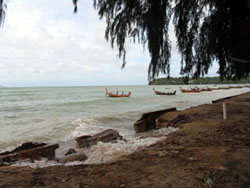

 | |||||||||||
|
|
Journals 2005/2006Susan Holt
May 9, 2005 Today, I traveled with Larry Mayer, Roland Arsenault, Don Fisher, Jamie Austin, Steffen Saustrup, Kate Collins, and Colin Ware to see the damage to the island of Phuket. We went through Kata and Patong beaches, where some of the original videos were taken of the large waves coming up on the beach. Again, there is much rebuilding going on and much recovery. It really stirred my emotions when I saw marks of what I think were graves along one of the beaches. Many people were busy with the construction of houses, businesses, and barriers along the beaches. You can see the pictures on postcards that show the beaches before, and then there I stood looking at them in real life as the "after picture." Much debris is on the beaches and the amount of sand seems to be much lower than in the "before" postcards. In the low areas, you can see the remains of buildings or the bottom floors of buildings without any windows or doors, just completely stripped.
When we returned to the resort, we packed our bags to meet the ship that was sailing from Singapore. As we waited, I heard even more about pirates and how departure is the most dangerous part of the Performer's trip. The ship did not arrive until after 6:00 pm. We boarded vans and the Darlow Smithson crew, which is in charge of the documentary for BBC1/ Discovery Channel, videotaped the start of the journey. That is when I realized what a big deal this production was going to be! The production team is Ed Wardle the producer/ director, Josh Talbot, sound, Vicki Young, assistant producer, Matt Green, cameraman, and Dudley Sargeant, editor. They jumped out to make sure they filmed footage of the expedition taking off, they jumped out to make sure they filmed footage of everyone getting out of the vans at the pier, then filmed us as we boarded. The production crew were everywhere with heavy equipment and little sleep. Once on board, we received room assignments and then had a safety briefing. Safety is taken very seriously. We had to climb into the life boat and then climb into our survival suits in case we had to abandon ship. Then we waited for a fire drill and an abandon ship drill that all crew participated in. I watched many of the exhausted scientists and support staff trying hard not to fall asleep, because of the combination of lack of sleep and/ or the effects of motion sickness medicine. Okay, so I watched through half shut eyes! Once we finished the drills, the ship was ready to leave the dock. I quietly went up on the bridge and asked the second mate, Jill, if I could stand out of the way and watch. The curtain was closed around the navigation room to keep light from reflecting off the windows, and Jill was working on the charts (maps) to plot our course. On the other side of the curtain was the bridge where the Captain was in control. Crew members, John and Mike came up a little before midnight, making four people watching our movement out of the harbor. The lights were off in the bridge and a spotlight was used to see possible problems. Then the huge ship moved gracefully away from the pier and out into the harbor. It was almost surreal to be so high up on such a massive piece of equipment, moving into the darkness with only a spotlight. Then I realized they were using radar to mark ships and to help make visual inspections. Mike walked around the bridge in a dizzying circle to mark possible hazards. The atmosphere was no nonsense and intense. I stayed tucked in the corner without saying a word. Finally, we were out into the harbor and hit the big waves and open sea. Mike and I were able to talk then, and I learned that Mike lives in North Alabama on the Tennessee River, which is close to where I grew up in Tennessee. He flies back to Alabama every five weeks! Once we moved out past a fleet of fishing vessels, I decided it was time to go get some sleep. I moved quietly through the galley and found the film crew, still up at 1:00 a.m., in a meeting!
|
||||||||||

